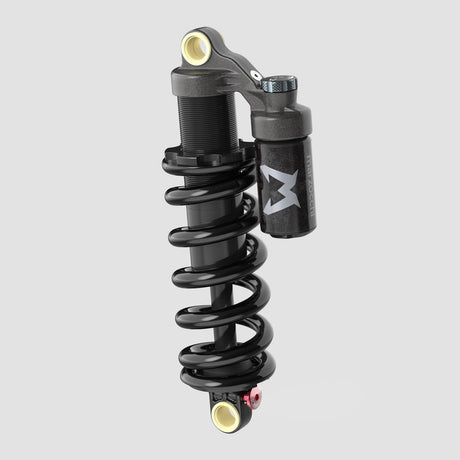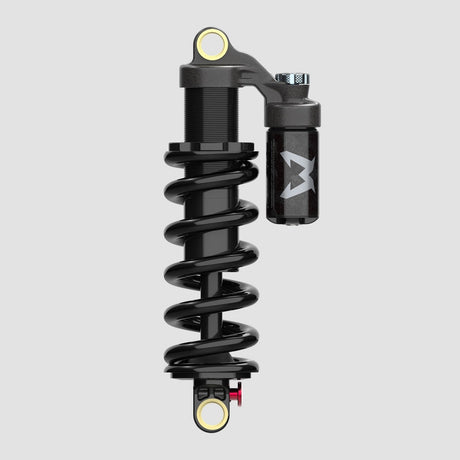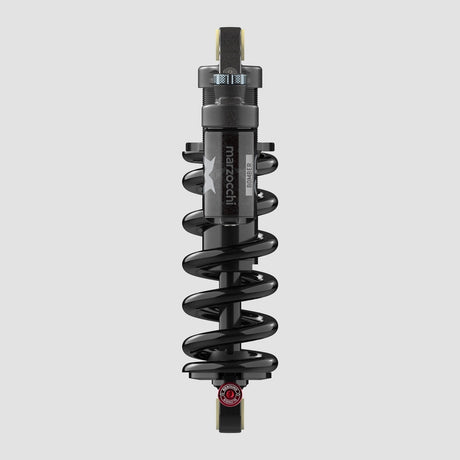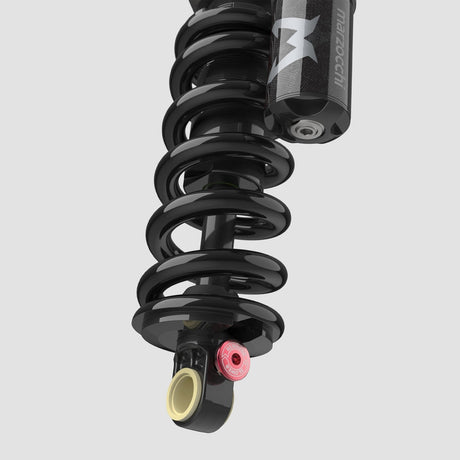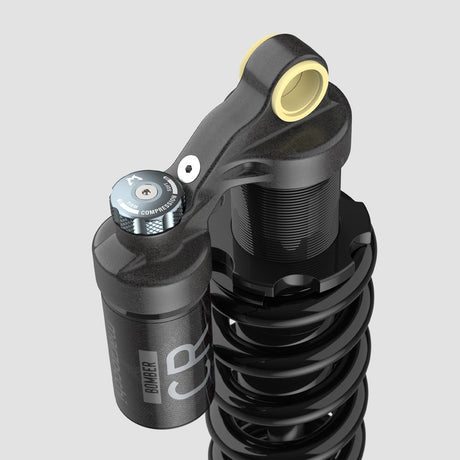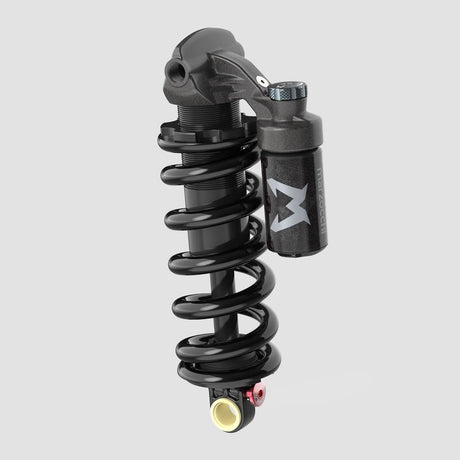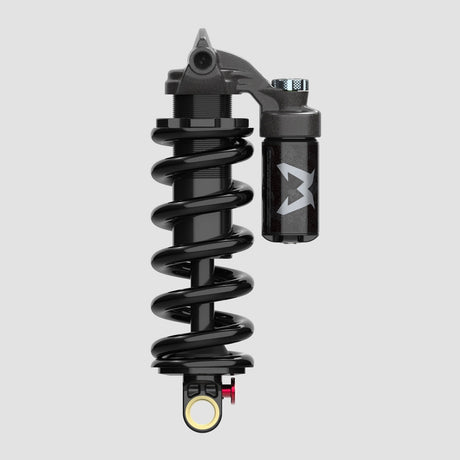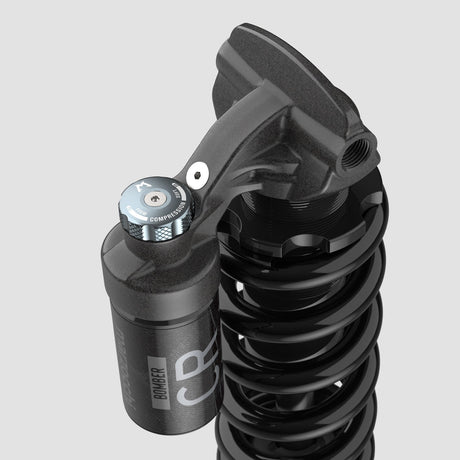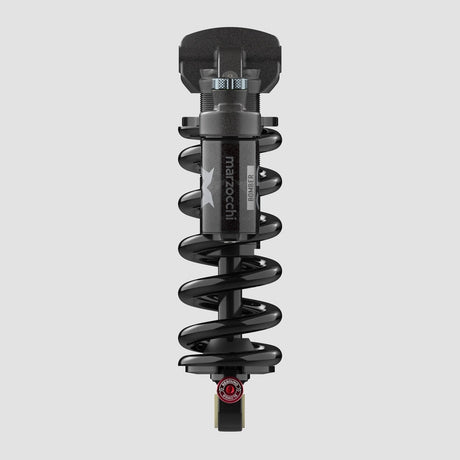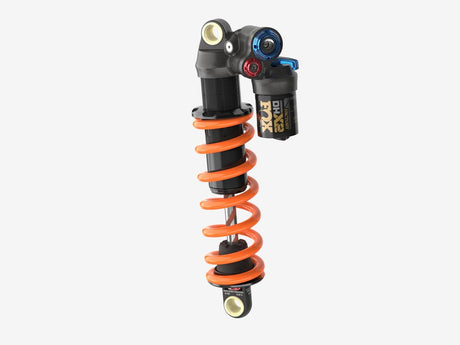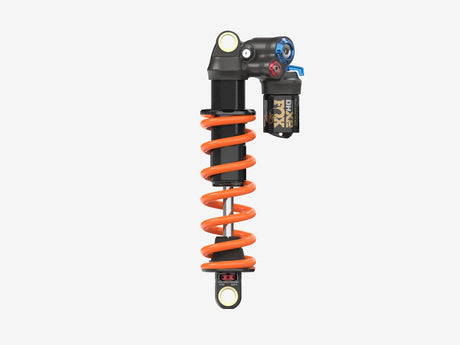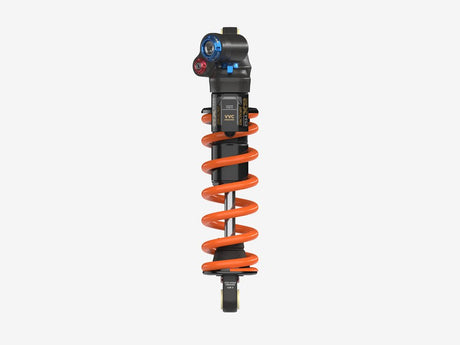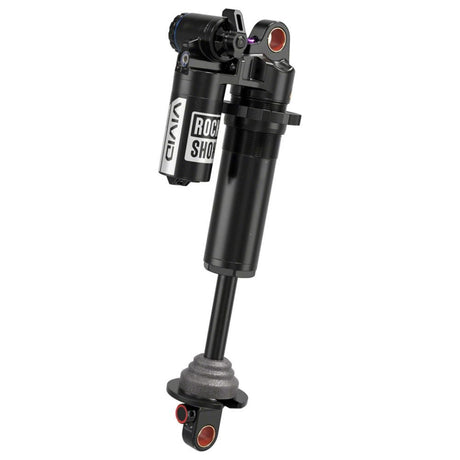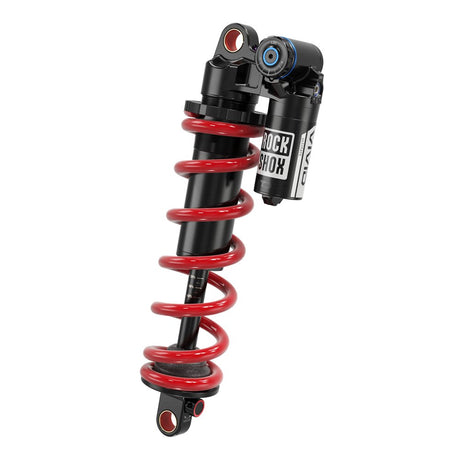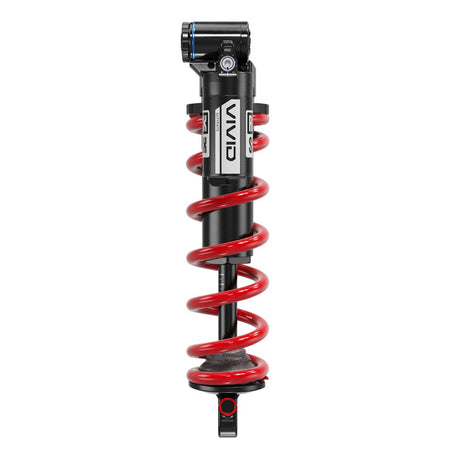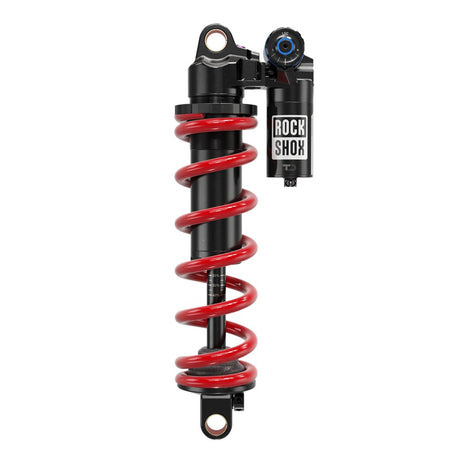Intro
The Specialized Stumpjumper EVO is extremely capable, versatile and FUN which makes it one of the most popular bikes on the trails. Like most mountain bikers, Stumpy EVO owners are always wondering if a coil shock will increase their bike’s performance. So here we are with the final installation of our 3 part video series to answer the big question:
Does the current generation of Stumpy EVO feel good with a coil shock?
Or should you stick with an air shock?
Stay tuned, and you’ll find out.
Comparing Coil Shocks On A Stumpy EVO
Putting A Coil Shock On A Stumpy EVO
I recently joined the huge community of Stumpy EVO owners.
We have so many customers with this bike, that I wanted to build one for myself to better assist everyone with their questions specific to this platform. Not just limited to Stumpy EVO owners, the question often arises of whether or not someone should switch to a coil shock to maximize their bike’s performance and fun.
When installing a coil shock for the first time on any bike, you’ll need to figure out which spring rate to get started with, which is exactly what I did in Part 1. Then, you’ll need to ride the new shock setup and feel out the riding characteristics of the spring rate you chose to start with, along with making some initial adjustments to the compression and rebound settings, which is what I did in Part 2. And here in Part 3, I’m going to share my full thoughts on how a coil shock feels on this model of bike to help you figure out if this is the best route for you, or if you should just stick with an air shock.
Before starting these tests, I was looking for answers to the following questions, which I will answer toward the end of this video.
- Will the added weight and slightly reduced playfulness of a coil shock reduce the overall fun factor and versatility of my Stumpy EVO? Or will the bike gain traction, give me more confidence and therefore be even more fun and versatile with a coil shock?
- Is the frame’s suspension platform progressive enough to be supportive for a linear coil spring? Or will I be fighting an uphill battle versus constant hard bottom-outs?
So first let’s talk about all of the shocks I tested and why I chose them.
The Shocks
Fox, RockShox, and Ohlins
My final goal was to find out if a coil shock feels good on this bike, but I also wanted to test out the air shocks that are most frequently installed on this bike to really have something to compare the coil shocks to. So I’ve ridden the Fox Float X Factory and RockShox Super Deluxe Ultimate air shocks, and then followed by riding the RockShox Super Deluxe Coil Ultimate and Ohlins TTX22M.2 coil shocks.
The Fox Float X comes stock on most Stumpy EVO builds, and I really wanted to set a baseline for myself to see how the bike rides with the model of shock that is most commonly installed on these bikes. The RockShox Super Deluxe Ultimate air shock is a direct contender for the Float X, and even comes stock on certain builds of the Stumpy EVO. You can also now buy the Super Deluxe Ultimate air shock aftermarket specifically for the Stumpy EVO with a frame specific tune and hydraulic bottom out, so I wanted to test those back to back due to their easy accessibility for riders.
Air vs Coil
Next, it was time to test some coil shocks. But first, here’s a quick summary of why people often see coil shocks as a better-performing alternative to air shocks, and why we’re even doing this test. Coil shocks support your weight with a coil spring rather than compressed air, which reduces the amount of overall seals and friction in the shock. This means there is less breakaway force required to compress the shock, and less overall heat. So coil shocks are generally going to be extremely sensitive on small bumps, and feel very consistent on long downhills with less heat working against them. Some quick disadvantages are that they’re heavier than air shocks, you have to spend some time and money figuring out which coil spring feels best for you and your bike, and they naturally tend to feel a little less playful than air shocks.
Why I chose the Super Deluxe and TTX22M.2
So as I mentioned in both part 1 and 2, there are only certain models of coil shocks that are “approved” for use on this bike due to the shock link/extension/yoke/clevis, whatever you want to call it. This suspension layout puts more side load on the shock as it compresses compared to other suspension layouts out there, and only certain shock designs have been approved for that increased load to avoid damage or constant maintenance.
I chose to start the coil shock testing with the RockShox Super Deluxe Ultimate coil shock, because we think their features and performance create an incredible value, and we truly recommend this shock to almost everyone looking for the best bang for their buck when when they are looking to switch to a coil shock. It’s the cheapest “approved” coil shock for this bike, and I really believe this will be the most common choice for most Stumpy EVO riders who go the coil shock direction, so this is really where I wanted to start the testing. That shock also has hydraulic bottom out, which I think really comes in handy for almost any coil shock installed on any bike out there.
After I released Part 2, many of the comments requested that I test out another popular approved coil shock option - the Ohlins TTX22M.2. This is what I’ve seen to be the next most popular approved option, and was also excited to see how a coil shock without hydraulic bottom out felt on the bike to test out a more “traditional”, linear coil shock setup without any bottom out assistance.
These tests were all done with the stock shock link, and not the aftermarket Cascade link. This is because I really like to test out one component switch at a time, and also because this ends up adding over $250. I wanted this test to be most relatable to the majority of riders who are looking for better performance without forking out a ton of money at once. I’m still interested in trying out a Cascade Link and they seem like an awesome piece of gear, but that’s for another set of tests, at least in my eyes.
So now that you understand why I chose the shocks for this test, let’s talk about how they feel. First I’ll talk about how the coil shocks felt, and then we’ll circle back to the air shocks to compare everything at the end.
Coil Shock Testing
I don’t really want to get too deep into the weeds on general riding characteristics of air versus coil shocks, so I’ll start by saying that I felt all of the same general positive characteristics you’d feel on any bike when using a coil shock. This includes awesome traction on climbs and descents, a very active shock feeling which creates a super smooth and supple ride, and the linear spring rate made the bike feel like it had more travel. What I’m really feeling for are any of the negative characteristics that you can run into when using coil shocks, since these tend to be very specific to frame design and ultimately make up your mind on which type of shock you stick with long term. This way, I can compare the pro’s and con’s to see which style of shock I think is better suited for the attitude of the Stumpjumper EVO, and how I want to ride it.
RockShox Super Deluxe Ultimate Coil
I started with the RockShox Super Deluxe Ultimate Coil, with a 400 pound standard linear spring which gave me 28% sag as a 150 pound rider.
When first dropping into a descent with a new coil shock setup, I immediately feel out the support through both the mid- and end-stroke to see how my starting coil spring rate feels. Since I chose a spring rate that got me 28% sag, which I’ll count as just about perfect with a coil spring, I was excited to see how the support felt.
I will say that I felt basically no issues with this.
The linear spring rate made the bike feel like it had more travel than with an air shock, since the linear coil spring doesn’t ramp up nearly as much. This is usually an issue on bikes with a very linear suspension design, creating consistently harsh bottom-outs, but with the HBO feature on this RockShox coil shock, this was not an issue. While I could feel the bike bottom out on bigger impacts, it almost felt good - thanks to the HBO. A bizarre feeling indeed. It didn’t really feel like a bottom out in a negative way, more so just a gentle reminder that I used all of my travel when over shooting a jump.
The HBO feature has 5 possible positions to control how aggressive the bottom out control hits and I tested it in all 5 positions. Ultimately, I settled in the -1 position as it just felt pretty dang good right there for trail riding, but I could see myself bumping that up to the +1 or +2 position if I got the freeride bug to go hit some bigger jumps and drops consistently.
Let’s not forget about the mid-stroke support, which felt great and was plenty supportive. I didn’t feel like the rear end felt too soft and wallowy while pumping and pushing through corners, which can sometimes happen with a more plush suspension setup. I had a great time getting my body in an aggressive riding stance and really pushing the bike to its limit. Luckily, the geometry of the Stumpy EVO is awesome for aggressive riding, and I feel like the coil shock complimented the geometry very well.
Overall, I was extremely impressed with the first ride with the coil shock on this bike. I will say, I’ve ridden some bikes with coil shocks that just didn’t feel good, but I can confidently say this was one of the most enjoyable experiences I’ve had with a coil shock on a trail bike.
Over the years I’ve preferred high end air shocks over coil shocks since they tend to make the bike the most poppy and fun. Since that’s how I typically like to focus my bike setup, modern air shocks just feel so dang good without adding weight to my bike.
I didn’t feel like I lost out on any of the fun factor with this RockShox coil shock on the Stumpy EVO.
Instead, I felt like the bike was actually more fun in many ways, which I admit, I was not expecting. The feeling of having more travel with the coil shock on this Stumpy EVO was one of my favorite aspects. With an air shock, I always felt like this bike feels like it has a little less travel than the 150mm it’s labeled with due to its overall supportive design. It’s a fast and supportive suspension platform feeling. With the coil shock, it definitely feels like it has 150mm of very useful travel, but without any negative side effects of harsh bottom outs due to HBO. I can definitely say I felt more confident riding at high speeds with the coil shock, while also maintaining the fun and versatile attitude of the bike.
Öhlins TTX22 M.2
After riding the RockShox coil shock for a bit, I actually filmed this part 3 video a few weeks ago. However, the comments in part 2 asked to try another option, so I scrapped that footage and installed an Ohlins TTX22M.2 which actually ended up completely changing my thoughts on how a coil shock feels on this bike.
Just like with the RockShox shock, I started with a normal linear spring. Ohlins doesn’t have a 400 pound spring, so I had to choose between a 388 or 411 pound spring rate. I didn’t want to decrease sag and make the ride more stiff, so I chose the 388 to measure at 30% sag which is usually my target sag.
I’ll compare the performance of these 2 shocks in a minute, but first let’s talk about bottom out support of the coil shock without a hydraulic bottom out feature and a spring rate that measures at 30% sag. I rode the same set of trails quite often to test these shocks, and with the Ohlins coil shock I found myself experiencing a harsh bottom out quite often. This shock has a rubber bottom out bumper as seen on many models of coil shocks, and that rubber bumper didn’t seem to stand a chance against the Stumpjumper EVO’s suspension curve. It proved to just be a bit too linear for a more standard coil shock setup to feel best. The rest of the stroke felt just as supportive and supple as the RockShox setup, but it goes to show just how valuable that HBO feature is for a bike like this.
To battle the bottom outs, I swapped to a Cane Creek Progressive Spring with a 400+ spring rate which ramps up to a 488 pound rate towards the end of the stroke. The progression is rated to start halfway through the stroke according to Cane Creek, and I could definitely feel it.
Two things were changed by adding the progressive spring:
- First, it became harder to bottom out the bike. I could still feel a hard bottom out like before, but perhaps about 70% less. That’s a huge improvement, but still nowhere near as comfortable and confidence inspiring as the RockShox shock with HBO.
- Second, the progressive spring reduced the feeling of having more travel since it ramped up halfway through the stroke.
So the Ohlins shock and progressive spring had reduced the increased confidence I had from feeling like I had more travel, and I could still feel an uncomfortable bottom out. I tried working with the compression adjustments on the Ohlins shock to try and slow down the shock’s compression, but I just kept feeling like the shock became overly harsh and the benefits of increased sensitivity of a coil shock was greatly reduced. Worth mentioning is that I didn’t feel the need to try a progressive spring on the RockShox shock, since the HBO feature cradled me at the bottom of the stroke more than enough, and I really liked how the linear spring felt. Overall, I just wasn’t really happy with the Ohlins shock and progressive spring setup on this bike.
RockShox Super Deluxe Ultimate Coil vs Öhlins TTX22 M.2
This does lead me into comparing the RockShox Super Deluxe Coil Ultimate versus the Ohlins TTX22M.2 since these are the 2 most common coil shocks that are making their way on the Stumpy EVO’s around the world.
In my opinion, the RockShox Super Deluxe Coil Ultimate feels absolutely amazing,
while the Ohlins TTX22M.2 just feels alright
We did some back to back test laps where I rode the same trail twice and swapped shocks between laps. I started with the Ohlins shock and progressive spring, then swapped to the RockShox shock. The Super Deluxe immediately felt to be a much more smooth shock. The Ohlins shock had a bit of a clunky top-out feeling, while the RockShox didn’t. The RockShox shock feels like a precision engineered mountain bike shock, while the Ohlins feels a bit more like a heavy duty moto shock that ended up on a mountain bike. This makes sense since RockShox has always been a dedicated mountain bike suspension brand, while Ohlins has primarily been a motorsports brand throughout their history.
I’ve also ridden the air versions of the Ohlins shock, and had similar feelings about those. However, Ohlins forks do feel pretty awesome, and have their own individual feeling that sets them apart from other options when comparing many models of popular forks, but that’s an entirely different subject.
I’d say the RockShox is definitely a much better option than the Ohlins for the Stumpjumper EVO, especially considering the price. The RockShox shock and linear spring costs $598, and the Ohlins shock and progressive spring which totals up to $925.
Does A Coil Shock Feel Good On A Stumpjumper EVO
Now that I’ve spent the time on several shocks, set up as well as I could for myself, I was able to answer the main questions of this test.
Does a coil shock feel good on the Stumpjumper EVO, in my opinion?
From my testing, my answer is YES, but only with a coil shock with hydraulic bottom out support if you are riding aggressively.
If you’re riding more tame and your wheels aren’t often leaving the ground, I think you’d be happy with one of the approved shocks without a hydraulic bottom out feature and a linear spring, but you still might feel a harsh bottom out at times. I haven’t tried the Cascade Link which increases the frame’s progression, and that might decrease how often the bike bottoms out with the Ohlins shock and linear spring, but you’d have to spend an additional $250+. Still, the RockShox option feels incredible all on it’s own, and is over $300 less than the Ohlins setup even without the additional $250 Cascade Link in hopes to bottom out less.
While bottom out support is important, we also have to answer the other questions:
Did the added weight and slightly reduced playfulness of a coil shock reduce the overall fun factor and versatility of my Stumpy EVO? Or did the bike gain traction, give me more confidence and therefore be even more fun and versatile with a coil shock?
Well, I was expecting the former to be true, but I was pleasantly surprised that I believe the latter is true to me, when considering where and how I ride.
I usually experience a noticeable reduction in the playful attitude of bikes once a coil shock is bolted on, while I did sort of feel that to be true with the Ohlins coil shock, I barely felt that with the RockShox coil shock. I felt like I could ride faster and more composed, and that led me to having more speed to pop off of jumps with ease. While the Stumpy EVO’s aggressive geometry already blurs the lines between a trail and enduro bike, the coil shock edged it slightly closer toward feeling like an enduro bike without reducing much of it’s trail-friendly characteristics. Adding about 1 pound of weight to my bike is usually a con, but I felt like the pro’s quickly outweighed that for me.
I am just one of a zillion bike riders looking to make my Stumpjumper EVO perform as well as possible for myself, so let’s figure out whether or not a coil or air shock works best for you and your Stumpy EVO.
Is An Air Shock Or Coil Shock Better On A Stumpjumper EVO?
If you live in an area with aggressive trails, you prioritize the descending capability of your bike setup, and you’re looking to absolutely maximize traction and speed on your Stumpjumper EVO without spending a ridiculous amount of money, I can’t recommend the RockShox Super Deluxe Coil Ultimate enough.
It’s super adjustable, extremely smooth, and won’t totally obliterate your bank account. The HBO feature gives you a comfortable and confident feeling that you used all of your travel without feeling jarred and rattling your confidence. You’ll add about 1 pound of weight to your bike, but it’ll feel like it has more travel and you’ll feel more confident tackling aggressive terrain.
If you like how all of that sounds, but want a more boutique shock option, I’d probably recommend passing on the Öhlins and jumping up to an EXT Storia or PUSH ELEVENSIX since both of those shocks offer a hydraulic bottom out feature. However, these shocks are pretty dang expensive. Right now the EXT is $999, but that includes a spring as well. And the PUSH is $1,600. You could have nearly 3 of the RockShox coil shocks for the price of one ELEVENSIX. The PUSH is made in the USA, and super adaptable to other sizes in the future, but still that’s a huge leap in price.
So I’ve mainly been talking about how good a coil shock can feel on this bike, but let’s pump the brakes for a second and talk about air shocks.
A Quick Note On Air Shocks
Do I think the right coil shock setup feels awesome, and creates more versatility for where and how I ride my Stumpy EVO? Yes I do.
But do I also think that an air shock is going to be a better choice for most riders? Honestly, yes I do, for a few reasons which are really all related to the classic “air versus coil shock” debate.
An air shock will keep the bike lightweight, and naturally still have a very slight edge in the nimble and playful category, which fits the attitude of the Stumpjumper EVO very well. You also won’t need to mess with choosing coil springs, which can add up in price if you have to try a couple spring rates.
Fox Float X
The Fox Float X that commonly comes stock on these bikes already feels really, really nice. While it’s not my absolute favorite shock, it’s still an amazing performer, and you don’t have to pay anything for it since it came stock on the bike. And if your build has the Float X Performance model, you can add a low speed compression knob for $25 which creates enough adjustability that most riders will be plenty happy with.
Would I rather have the Ohlins coil shock over the Float X? Maybe, but only in some weird situation where I was given the choice between taking one or the other at the same price. That’s likely not going to happen, and I’d probably buy the RockShox coil shock and spend the difference in price on other upgrades or for a trip to ride somewhere fun. At the end of the day, most riders on these bikes are looking to keep the price reasonable, and are looking for the best bang for their buck upgrades. With that said, I don’t really feel like the Float X is holding the bike back for most riders that haven’t been riding for a super long time, and aren’t riding super aggressively.
RockShox Super Deluxe Ultimate Air
Alternatively, let’s look at the RockShox Super Deluxe Ultimate air shock, which might just be my main recommendation for most riders looking for the best performance without adding weight and maintaining 100% of that supportive and lively feel this bike offers.
This shock feels a bit more smooth and refined than the Float X in my opinion. If you score one of the Super Deluxe air shocks built specifically for this bike, you’ll get a slightly different tune than the generic aftermarket tune, and also the hydraulic bottom out feature. In my opinion, this Stumpy EVO specific model of Super Deluxe air shock is the best all-rounder option for most riders on this bike platform.
However, the standard aftermarket option with the off-the-shelf tune and without HBO is much easier to find, and you can also get it with the HBO feature without the bike specific tune which is slightly easier to find. But given the chance, definitely opt for the Stumpy EVO specific shock to maximize performance as the tune and HBO feature are definitely nice features. Lots of options here, and I think I’d rather have the HBO feature than the specific tune myself. But if I wanted to upgrade sooner than later, I’d probably just grab whichever was easiest to find in stock. I’ll have a link to all of these shocks on our website in the video description below.
Which Is Best For You Summary
To sum it all up, the Stumpjumper EVO’s lightweight and spry all-mountain attitude fits excellent with the characteristics of an air shock, but can lean slightly closer toward the enduro category with the right coil shock setup, all without sacrificing much of the lively characteristics as mentioned before. However, the bike’s suspension design with the stock shock link seems to be too linear for a traditional linear coil shock setup if you are riding aggressively, and you’ll want to choose a coil shock with a hydraulic bottom out feature to avoid harsh and jarring bottom outs.
What Is Staying On My Bike?
Well, that answer depends on what type of riding I’m more into at the moment, and maybe that can help with your decision.
For most of this Summer, I’ve been prioritizing longer rides to up my fitness, and have been riding trails that are fast, but not too aggressive. With that said, the RockShox Super Deluxe Ultimate air shock will be on my bike for now.
But lately I’ve been getting onto some more steep and aggressive trails again, so it’s likely that the Super Deluxe Ultimate Coil shock will make its way back on very soon.
If I had a Stumpy EVO frame and no shock, and had to go purchase only one shock on my own, I would probably buy the Super Deluxe Coil Ultimate for how I ride and where I live out here in the Pacific Northwest.
Summary
Before I say goodbye, here’s a few disclaimers of these tests. The RockShox coil shock I tested does have a tune specific to this bike which is progressive rebound and low compression. We’re still unclear whether or not this will be available in the aftermarket like the air version is, but I really don’t think most riders would notice much of a difference between the standard aftermarket tune which is the same besides linear rebound.
The EXT and PUSH shocks would include a custom tune when you buy those, but I don’t think the slightly different rebound tune of the RockShox coil shock warrants the huge leap to $1,000 or more for most riders. The RockShox shock can still be custom tuned internally if you want to do that down the line, but I would recommend just starting with the regular 210x55 aftermarket version of the shock. The Ohlins shock I tested had their general aftermarket tune as that is what Ohlins recommended to me for this bike.
UPDATE - 8/23/2023 - While performing this test, Fox labeled the Fox DHX rear shock as "not approved" for Specialized Stumpjumper EVO and Levo bikes. However, shortly after finishing this test, Fox contacted us to let me know that they have finished further testing of the DHX on these platforms. Their long-term testing shows that the DHX is compatible with these suspension designs, and the DHX is now approved for use on the Stumpjumper EVO and Levo. This shock does not have hydraulic bottom out, so I don't think it is going to be the right choice for more aggressive riders who are using lots of travel very often, but it is very simple to setup which some riders may appreciate.

